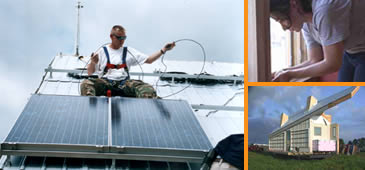our home
> system
> solar systems
> passive solar energy
One
of the easiest and most cost effective ways to capture
the power of the sun is via passive systems. Passive
systems are generally integrated into the structure
of the building and require no mechanical energy for
their operation. Instead, these systems rely on temperature
gradients created by the absorption of radiation to
move energy or fluids.
Architecture and
design go hand in hand with passive systems, as the
building itself functions as a solar collector or
storage unit. A home designed to work with the sun
can significantly impact the amount of electricity
needed to heat and cool a home or to light a home.
Before the advent of home heating and cooling systems,
southerners relied heavily on passive design principles
to make their homes comfortable during the long hot
summers and sometimes chilly winters.
Design principles
such as building
orientation, windows,
shading devices,
day lighting,
and the use of materials that absorb and transfer
heat, such as water
columns and ceramic floor tiles are some examples
of passive solar systems used in our home. In general
our home design is biased towards passive cooling
rather than heating. This strategy was chosen because
our homes cooling system is less efficient than our
heating systems.
|















